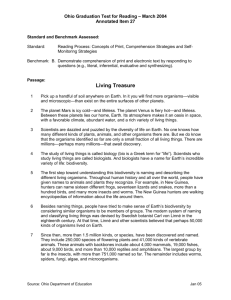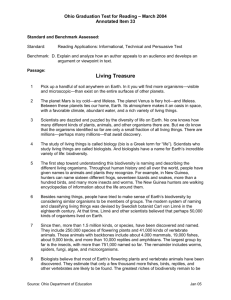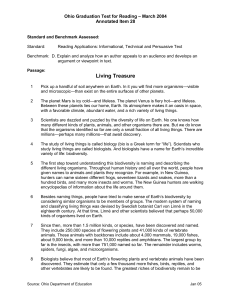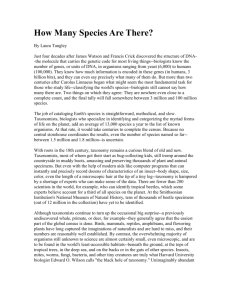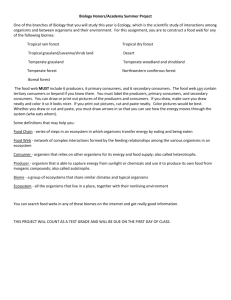Add Header – ODE Apple, no shaping
advertisement
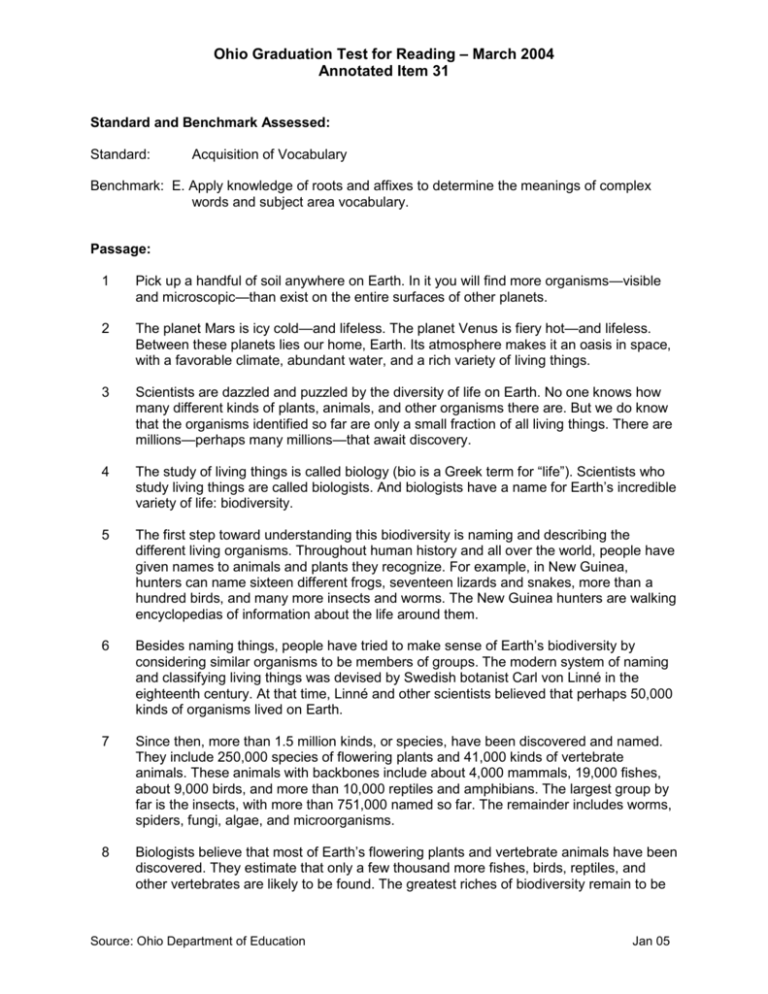
Ohio Graduation Test for Reading – March 2004 Annotated Item 31 Standard and Benchmark Assessed: Standard: Acquisition of Vocabulary Benchmark: E. Apply knowledge of roots and affixes to determine the meanings of complex words and subject area vocabulary. Passage: 1 Pick up a handful of soil anywhere on Earth. In it you will find more organisms—visible and microscopic—than exist on the entire surfaces of other planets. 2 The planet Mars is icy cold—and lifeless. The planet Venus is fiery hot—and lifeless. Between these planets lies our home, Earth. Its atmosphere makes it an oasis in space, with a favorable climate, abundant water, and a rich variety of living things. 3 Scientists are dazzled and puzzled by the diversity of life on Earth. No one knows how many different kinds of plants, animals, and other organisms there are. But we do know that the organisms identified so far are only a small fraction of all living things. There are millions—perhaps many millions—that await discovery. 4 The study of living things is called biology (bio is a Greek term for “life”). Scientists who study living things are called biologists. And biologists have a name for Earth’s incredible variety of life: biodiversity. 5 The first step toward understanding this biodiversity is naming and describing the different living organisms. Throughout human history and all over the world, people have given names to animals and plants they recognize. For example, in New Guinea, hunters can name sixteen different frogs, seventeen lizards and snakes, more than a hundred birds, and many more insects and worms. The New Guinea hunters are walking encyclopedias of information about the life around them. 6 Besides naming things, people have tried to make sense of Earth’s biodiversity by considering similar organisms to be members of groups. The modern system of naming and classifying living things was devised by Swedish botanist Carl von Linné in the eighteenth century. At that time, Linné and other scientists believed that perhaps 50,000 kinds of organisms lived on Earth. 7 Since then, more than 1.5 million kinds, or species, have been discovered and named. They include 250,000 species of flowering plants and 41,000 kinds of vertebrate animals. These animals with backbones include about 4,000 mammals, 19,000 fishes, about 9,000 birds, and more than 10,000 reptiles and amphibians. The largest group by far is the insects, with more than 751,000 named so far. The remainder includes worms, spiders, fungi, algae, and microorganisms. 8 Biologists believe that most of Earth’s flowering plants and vertebrate animals have been discovered. They estimate that only a few thousand more fishes, birds, reptiles, and other vertebrates are likely to be found. The greatest riches of biodiversity remain to be Source: Ohio Department of Education Jan 05 Ohio Graduation Test for Reading – March 2004 Annotated Item 31 discovered in the world of insects and other small creatures without backbones (invertebrates). 9 Biologists expect to find some of Earth’s undescribed organisms living in coral reefs. There also may be other undiscovered habitats, and species, on the floor of the deep ocean. In the 1980s, using small research submarines, scientists began to discover new forms of life—near geysers of hot, mineral-laden water that spew from the ocean floor. 10 Earth’s greatest riches, however, lie in tropical rain forests. In the 1980s, as funds for tropical research increased, biologists found astonishing numbers of animals there. 11 In Panama, entomologist Terry Erwin of the Smithsonian Institution collected insects from nineteen trees of the same species. On those trees alone, he found more than 12,000 different kinds of beetles. He estimated that one out of seven species lived on that kind of tree and no other. 12 Erwin also collected insects from one tree in the Amazon rain forest of Peru. He sent the ant specimens to be identified by biologist Edward O. Wilson of Harvard University. Wilson found forty-three kinds of ants, including several new species. This diversity of ants—from a single tropical tree—equaled the number of ant species that are known to live in all of Canada or Great Britain. 13 Tropical forests are also rich with plant life. In Borneo, a botanist discovered 700 species of trees growing on ten separate plots of land that totaled about twenty-five acres. This matches the number of tree species growing in all of North America. Also, the trunks and branches of rain forest trees are habitats for mosses, ferns, lichens, orchids, and other plants that grow far above the soil. In Costa Rica alone, more than 1,100 species of orchids have been identified. 14 In the 1980s, Terry Erwin and other biologists began for the first time to study insects, plants, and other organisms that live near the tops of tropical trees. The organisms living in the treetops, or canopy, of a rain forest are different from those living on or close to the ground. More than half of all rain forest species may live aloft. Most of them never touch the ground. Terry Erwin has called the tropical forest canopy “the heart” of Earth’s biodiversity. 15 Until the 1980s, biologists estimated that 3 to 5 million species live on Earth. However, since large numbers of tropical insects and other organisms may live on just one kind of tree, or in one small area of tropical forest, the biodiversity of Earth may be much greater. Terry Erwin has estimated that Earth may be home to 30 million species of insects alone. 16 The total of all kinds of life could be much higher. Rain forest canopies harbor not only 1 2 insects but also unknown numbers of mites , roundworms, fungi, and other small organisms. Little is known about life in tropical soils. And most animals have other living things, called parasites, living on or inside them. Source: Ohio Department of Education Jan 05 Ohio Graduation Test for Reading – March 2004 Annotated Item 31 17 Whether the total numbers of species is 5 million, 30 million, or more, we know very little about the biodiversity of our planet. Our ignorance is great. 18 Suppose the number of species is “only” 10 million. This means that we have perhaps discovered just 15 percent of the total number of species. Then consider that we have not yet learned much about the plants and animals that have been identified. Many of these organisms are “known” only in the sense that a few individuals are kept as preserved specimens in scientific collections and that they have been given a formal name. Multiple Choice Question: 31. Using information from the passage, which phrase is likely the meaning of the word “microbiology”? A. the study of very small organisms B. the study of very ancient organisms C. the study of very complex organisms D. the study of very rare organisms Commentary: This multiple choice question asks a student to use his or her knowledge of the meaning of the prefix micro- with the meaning of the suffix –logy and combine this knowledge with the Greek root word “bio,” to determine the meaning of the word microbiology. The passage contains words like microscopic and microorganism used in the context of references to very small living things. It also contains in paragraph 4 the sentence, “Scientists who study living things are called biologists.” From this sentence a student may determine the suffix –logy means “to study”. These context clues along with the definition for bio provided in paragraph 4 and students’ prior knowledge about the prefix micro- taken from contact with words like microchip and microscope enable a student to select response A as the correct answer. There are no definitions or clues in the passage to misguide a reader into defining the prefix micro- to mean ancient, complex or rare. Thus, responses B, C and D are incorrect. Performance Data: The percent of public school students selecting answer choice A for question 31 on the March 2004 Ohio Graduation Test for Reading was 80%. Keywords: Prefixes, Suffixes, Roots Link Passage: Living Treasures Source: Ohio Department of Education Jan 05
